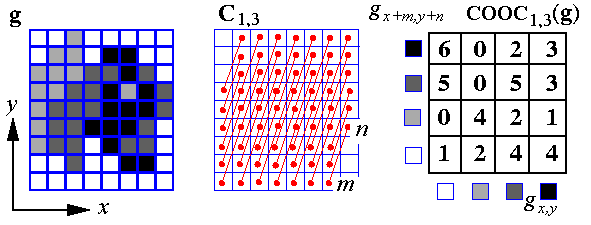Tamura texture features
来源:互联网 发布:知乎白云先生是谁 编辑:程序博客网 时间:2024/06/15 13:12

上图是灰度共生矩阵的原理图。
原理可以详细阅读有关论文,这里有详细介绍:查看链接
基于人类对纹理的视觉感知的心理学的研究,Tamura等人提出了纹理特征的表达[14]。Tamura纹理特征的六个分量对应于心理学角度上纹理特征的六种属性,分别是粗糙度(coarseness)、对比度(contrast)、方向度(directionality)、 线像度(linelikeness)、规整度(regularity)和粗略度(roughness)。其中,前三个分量对于图像检索尤其重要
Tamura's Texture Features
Today's CBIR systems use in most cases the set of six visual features, namely,
- coarseness,
- contrast,
- directionality,
- linelikeness,
- regularity,
- roughness
Coarseness relates to distances of notable spatial variations of grey levels, that is, implicitly, to the size of the primitive elements (texels) forming the texture. The proposed computational procedure accounts for differences between the average signals for the non-overlapping windows of different size:
- At each pixel (x,y), compute six averages for the windows of size 2k × 2k, k=0,1,...,5, around the pixel.
- At each pixel, compute absolute differencesEk(x,y) between the pairs of nonoverlapping averages in the horizontal and vertical directions.
- At each pixel, find the value of k that maximises the difference Ek(x,y) in either direction and set the best size Sbest(x,y)=2k.
- Compute the coarseness feature Fcrs by averaging Sbest(x,y) over the entire image.
Instead of the average of Sbest(x,y, an improved coarseness feature to deal with textures having multiple coarseness properties is a histogram characterising the whole distribution of the best sizes over the image (Castelli & Bergman, 2002).
Contrast measures how grey levels q; q = 0, 1, ..., qmax, vary in the image g and to what extent their distribution is biased to black or white. The second-order and normalised fourth-order central moments of the grey level histogram (empirical probability distribution), that is, the variance, σ2, and kurtosis, α4, are used to define the contrast:  where
where  and m is the mean grey level, i.e. the first order moment of the grey level probability distribution. The value n=0.25 is recommended as the best for discriminating the textures.
and m is the mean grey level, i.e. the first order moment of the grey level probability distribution. The value n=0.25 is recommended as the best for discriminating the textures.
Degree of directionality is measured using the frequency distribution of oriented local edges against their directional angles. The edge strength e(x,y) and the directional angle a(x,y) are computed using the Sobel edge detector approximating the pixel-wise x- and y-derivatives of the image:
where Δx(x,y) and Δy(x,y) are the horizontal and vertical grey level differences between the neighbouring pixels, respectively. The differences are measured using the following 3 × 3 moving window operators:
A histogram Hdir(a) of quantised direction values a is constructed by counting numbers of the edge pixels with the corresponding directional angles and the edge strength greater than a predefined threshold. The histogram is relatively uniform for images without strong orientation and exhibits peaks for highly directional images. The degree of directionality relates to the sharpness of the peaks:

where np is the number of peaks, ap is the position of the pth peak, wp is the range of the angles attributed to the pth peak (that is, the range between valleys around the peak), r denotes a normalising factor related to quantising levels of the angles a, and a is the quantised directional angle (cyclically in modulo 180o).
Three other features are highly correlated with the above three features and do not add much to the effectiveness of the texture description. The linelikeness feature Flin is defined as an average coincidence of the edge directions (more precisely, coded directional angles) that co-occurred in the pairs of pixels separated by a distance d along the edge direction in every pixel. The edge strength is expected to be greater than a given threshold eliminating trivial "weak" edges. The coincidence is measured by the cosine of difference between the angles, so that the co-occurrences in the same direction are measured by +1 and those in the perpendicular directions by -1.
The regularity feature is defined as Freg=1-r(scrs+scon+sdir + slin) where r is a normalising factor and each s... means the standard deviation of the corresponding feature F... in each subimage the texture is partitioned into. The roughness feature is given by simply summing the coarseness and contrast measures: Frgh=Fcrs+Fcon
In the most cases, only the first three Tamura's features are used for the CBIR. These features capture the high-level perceptual attributes of a texture well and are useful for image browsing. However, they are not very effective for finer texture discrimination (Castelli & Bergman, 2002).
- Tamura texture features
- Tamura texture C++实现
- CBIR: Texture Features 基于内容的图像检索:纹理特征
- 2017-trans-Alzheimer’s Disease Classification 3-D Texture Features
- Texture
- texture
- Tamura纹理特征
- [图像] Tamura纹理
- Features
- Features
- 图像tamura特征提取<一>
- Tamura纹理特征的matlab实现
- Tamura纹理特征的matlab实现
- ActiveMq Features--- Consumer Features
- Assembling Features Reading Features
- projective texture
- Texture mapping
- Texture Mapping
- jstl学习整理
- 一个android monkey自动化脚本demo
- .ko内核模块文件以及载入模块命令modprobe insmod
- 想成为嵌入式程序员应知道的0x10个基本问题
- .net大文件上传
- Tamura texture features
- SecureCRT 显示配置项修改
- libnet libcap 安装
- 每个程序员都应该知道的福利
- linux设备模型详解
- C028: "Unable to Connect to the Siebel Gateway Name Server
- MySQL数据库优化实践
- ESFramework Demo -- 简单的网络硬盘Demo(附源码)
- 颠倒栈


